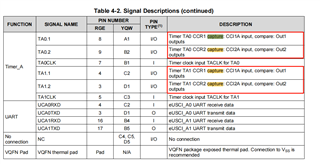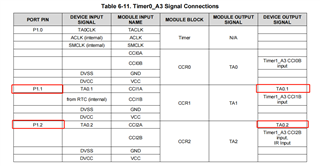你好,
我们想确认一下,在MSP430FR2433芯片上调试定时器捕获功能,我们将P2.3作为捕获引脚,请帮助确认一下该引脚是否可以作为捕获引脚使用?
因为我们在文档内查看到下述信息,是否只有P1.1/P1.2/P1.4/P1.5可以用作捕获引脚功能?



This thread has been locked.
If you have a related question, please click the "Ask a related question" button in the top right corner. The newly created question will be automatically linked to this question.
你好,
我们想确认一下,在MSP430FR2433芯片上调试定时器捕获功能,我们将P2.3作为捕获引脚,请帮助确认一下该引脚是否可以作为捕获引脚使用?
因为我们在文档内查看到下述信息,是否只有P1.1/P1.2/P1.4/P1.5可以用作捕获引脚功能?



是否只有P1.1/P1.2/P1.4/P1.5可以用作捕获引脚功能?
是的,您的理解是正确的
msp430fr243x_ta0_capture.c (ti.com)
你好,如果我想将改示例代码内的P1.2捕获引脚改为P1.5捕获引脚,具体代码如下:
我尝试将TA0.CCI2A(P1.2)修改为TA1.CCI1A(P1.5),但是现在回调功能不触发,可以帮助分析一下吗?
#include <msp430.h>
#define NUMBER_TIMER_CAPTURES 20
volatile unsigned int timerAcaptureValues[NUMBER_TIMER_CAPTURES];
unsigned int timerAcapturePointer = 0;
int main(void)
{
WDTCTL = WDTPW | WDTHOLD; // Stop watchdog timer
// Configure GPIO
P1DIR |= BIT0; // Set P1.0 as output
P1OUT |= BIT0; // P1.0 high
P1SEL1 |= BIT5; // TA0.CCI2A input capture pin, second function
P1REN |= BIT5; // enable internal pull-down resistor
P1OUT &= ~BIT5;
P2SEL1 |= BIT2; // Set as ACLK pin, second function
P2DIR |= BIT2;
// Disable the GPIO power-on default high-impedance mode to activate
// previously configured port settings
PM5CTL0 &= ~LOCKLPM5;
// Configure clock
__bis_SR_register(SCG0); // disable FLL
CSCTL3 |= SELREF__REFOCLK; // Set REFO as FLL reference source
CSCTL0 = 0; // clear DCO and MOD registers
CSCTL1 &= ~(DCORSEL_7); // Clear DCO frequency select bits first
CSCTL1 |= DCORSEL_2; // Set DCO = 4MHz
CSCTL2 = FLLD_1 + 60; // DCODIV = 2MHz
__delay_cycles(3);
__bic_SR_register(SCG0); // enable FLL
while(CSCTL7 & (FLLUNLOCK0 | FLLUNLOCK1)); // Poll until FLL is locked
CSCTL4 = SELMS__DCOCLKDIV | SELA__REFOCLK; // set default REFO(~32768Hz) as ACLK source, ACLK = 32768Hz
// default DCODIV as MCLK and SMCLK source
CSCTL5 |= DIVM__1 | DIVS__2; // SMCLK = 1MHz, MCLK = 2MHz
// Timer0_A3 Setup
TA1CCTL1 |= CM_1 | CCIS_0 | CCIE | CAP | SCS;
// Capture rising edge,
// Use CCI2A=ACLK,
// Synchronous capture,
// Enable capture mode,
// Enable capture interrupt
TA1CTL |= TASSEL_2 | MC_2 | TACLR; // Use SMCLK as clock source, clear TA0R
// Start timer in continuous mode
__bis_SR_register(LPM0_bits | GIE);
__no_operation();
}
// Timer0_A3 CC1-2, TA Interrupt Handler
#if defined(__TI_COMPILER_VERSION__) || defined(__IAR_SYSTEMS_ICC__)
#pragma vector = TIMER1_A1_VECTOR
__interrupt void TIMER1_A1_ISR(void)
#elif defined(__GNUC__)
void __attribute__ ((interrupt(TIMER0_A1_VECTOR))) TIMER0_A1_ISR (void)
#else
#error Compiler not supported!
#endif
{
switch(__even_in_range(TA1IV,TA1IV_TAIFG))
{
case TA1IV_NONE:
break; // No interrupt
case TA1IV_TACCR1:
timerAcaptureValues[timerAcapturePointer++] = TA1CCR1;
if (timerAcapturePointer >= 20)
{
while (1)
{
P1OUT ^= 0x01; // Toggle P1.0 (LED)
__delay_cycles(100000);
}
}
break; // CCR1 not used
case TA1IV_TACCR2:
break; // CCR2 not used
case TA1IV_TAIFG:
break; // overflow
default:
break;
}
}下面是我之前成功测试1.4的,您可以看一下,我也来测试一下1.5
/* --COPYRIGHT--,BSD_EX
* Copyright (c) 2014, Texas Instruments Incorporated
* All rights reserved.
*
* Redistribution and use in source and binary forms, with or without
* modification, are permitted provided that the following conditions
* are met:
*
* * Redistributions of source code must retain the above copyright
* notice, this list of conditions and the following disclaimer.
*
* * Redistributions in binary form must reproduce the above copyright
* notice, this list of conditions and the following disclaimer in the
* documentation and/or other materials provided with the distribution.
*
* * Neither the name of Texas Instruments Incorporated nor the names of
* its contributors may be used to endorse or promote products derived
* from this software without specific prior written permission.
*
* THIS SOFTWARE IS PROVIDED BY THE COPYRIGHT HOLDERS AND CONTRIBUTORS "AS IS"
* AND ANY EXPRESS OR IMPLIED WARRANTIES, INCLUDING, BUT NOT LIMITED TO,
* THE IMPLIED WARRANTIES OF MERCHANTABILITY AND FITNESS FOR A PARTICULAR
* PURPOSE ARE DISCLAIMED. IN NO EVENT SHALL THE COPYRIGHT OWNER OR
* CONTRIBUTORS BE LIABLE FOR ANY DIRECT, INDIRECT, INCIDENTAL, SPECIAL,
* EXEMPLARY, OR CONSEQUENTIAL DAMAGES (INCLUDING, BUT NOT LIMITED TO,
* PROCUREMENT OF SUBSTITUTE GOODS OR SERVICES; LOSS OF USE, DATA, OR PROFITS;
* OR BUSINESS INTERRUPTION) HOWEVER CAUSED AND ON ANY THEORY OF LIABILITY,
* WHETHER IN CONTRACT, STRICT LIABILITY, OR TORT (INCLUDING NEGLIGENCE OR
* OTHERWISE) ARISING IN ANY WAY OUT OF THE USE OF THIS SOFTWARE,
* EVEN IF ADVISED OF THE POSSIBILITY OF SUCH DAMAGE.
*
*******************************************************************************
*
* MSP430 CODE EXAMPLE DISCLAIMER
*
* MSP430 code examples are self-contained low-level programs that typically
* demonstrate a single peripheral function or device feature in a highly
* concise manner. For this the code may rely on the device's power-on default
* register values and settings such as the clock configuration and care must
* be taken when combining code from several examples to avoid potential side
* effects. Also see www.ti.com/grace for a GUI- and www.ti.com/msp430ware
* for an API functional library-approach to peripheral configuration.
*
* --/COPYRIGHT--*/
//***************************************************************************************
// MSP430FR24xx Demo - Timer0_A3 Capture of ACLK
//
// Description: Capture a number of periods of the ACLK clock and store them in an array.
// When the set number of periods is captured the program is trapped and the LED on
// P1.0 is toggled. At this point halt the program execution read out the values using
// the debugger.
// ACLK = REFOCLK = 32kHz, MCLK = SMCLK = default DCODIV = 1MHz.
//
// MSP430FR2433
// -----------------
// /|\| |
// | | P1.2|<-- TA0.CCI2A
// --|RST | |
// | P2.2|--> ACLK
// | |
// | P1.0|-->LED
//
//
// Wei Zhao
// Texas Instruments Inc.
// Jan 2014
// Built with IAR Embedded Workbench v6.20 & Code Composer Studio v6.0.1
//***************************************************************************************
#include <msp430.h>
#define NUMBER_TIMER_CAPTURES 20
volatile unsigned int timerAcaptureValues[NUMBER_TIMER_CAPTURES];
unsigned int timerAcapturePointer = 0;
int main(void)
{
WDTCTL = WDTPW | WDTHOLD; // Stop watchdog timer
// Configure GPIO
P1DIR |= BIT0; // Set P1.0 as output
P1OUT |= BIT0; // P1.0 high
P1SEL1 |= BIT4; // TA0.CCI2A input capture pin, second function
P1REN |= BIT4; // enable internal pull-down resistor
P1OUT &= ~BIT4;
P2SEL1 |= BIT2; // Set as ACLK pin, second function
P2DIR |= BIT2;
// Disable the GPIO power-on default high-impedance mode to activate
// previously configured port settings
PM5CTL0 &= ~LOCKLPM5;
// Configure clock
__bis_SR_register(SCG0); // disable FLL
CSCTL3 |= SELREF__REFOCLK; // Set REFO as FLL reference source
CSCTL0 = 0; // clear DCO and MOD registers
CSCTL1 &= ~(DCORSEL_7); // Clear DCO frequency select bits first
CSCTL1 |= DCORSEL_2; // Set DCO = 4MHz
CSCTL2 = FLLD_1 + 60; // DCODIV = 2MHz
__delay_cycles(3);
__bic_SR_register(SCG0); // enable FLL
while(CSCTL7 & (FLLUNLOCK0 | FLLUNLOCK1)); // Poll until FLL is locked
CSCTL4 = SELMS__DCOCLKDIV | SELA__REFOCLK; // set default REFO(~32768Hz) as ACLK source, ACLK = 32768Hz
// default DCODIV as MCLK and SMCLK source
CSCTL5 |= DIVM__1 | DIVS__2; // SMCLK = 1MHz, MCLK = 2MHz
// Timer0_A3 Setup
TA1CCTL2 |= CM_1 | CCIS_0 | CCIE | CAP | SCS;
// Capture rising edge,
// Use CCI2A=ACLK,
// Synchronous capture,
// Enable capture mode,
// Enable capture interrupt
TA1CTL |= TASSEL_2 | MC_2 | TACLR; // Use SMCLK as clock source, clear TA0R
// Start timer in continuous mode
__bis_SR_register(LPM0_bits | GIE);
__no_operation();
}
// Timer0_A3 CC1-2, TA Interrupt Handler
#if defined(__TI_COMPILER_VERSION__) || defined(__IAR_SYSTEMS_ICC__)
#pragma vector = TIMER1_A1_VECTOR
__interrupt void TIMER1_A1_ISR(void)
#elif defined(__GNUC__)
void __attribute__ ((interrupt(TIMER1_A1_VECTOR))) TIMER1_A1_ISR (void)
#else
#error Compiler not supported!
#endif
{
switch(__even_in_range(TA1IV,TA1IV_TAIFG))
{
case TA1IV_NONE:
break; // No interrupt
case TA1IV_TACCR1:
break; // CCR1 not used
case TA1IV_TACCR2:
timerAcaptureValues[timerAcapturePointer++] = TA0CCR2;
if (timerAcapturePointer >= 20)
{
while (1)
{
P1OUT ^= 0x01; // Toggle P1.0 (LED)
__delay_cycles(100000);
}
}
break; // CCR2 not used
case TA1IV_TAIFG:
break; // overflow
default:
break;
}
}
你好,我刚尝试了一下,将您提供的P1.4下述代码进行修改:
// Timer0_A3 Setup
TA1CCTL2 |= CM_1 | CCIS_0 | CCIE | CAP | SCS;
修改为
// Timer0_A3 Setup
TA1CCTL1 |= CM_1 | CCIS_0 | CCIE | CAP | SCS;
此时P1.5下拉可以触发中断,此时触发的是中断 TA1IV_TACCR1
但是TA0CCR2参数想确认一下,0和2是依据什么修改的?因为此时从TA0CCR2获取的参数是0,所以可能需要尝试其他参数
但是TA0CCR2参数想确认一下,0和2是依据什么修改的?
SFR_16BIT(TA0CCR0); /* Timer0_A3 Capture/Compare 0 */
SFR_16BIT(TA0CCR1); /* Timer0_A3 Capture/Compare 1 */
SFR_16BIT(TA0CCR2); /* Timer0_A3 Capture/Compare 2 */‘
上面是"msp430fr2433.h"内的描述
此时P1.5下拉可以触发中断,此时触发的是中断 TA1IV_TACCR1
SFR_16BIT(TA1CCTL1); /* Timer1_A3 Capture/Compare Control 1 */
SFR_16BIT(TA1CCTL2); /* Timer1_A3 Capture/Compare Control 2 */